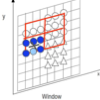Using trend clusters for spatiotemporal interpolation of missing data in a sensor network
Keywords:
spatiotemporal data mining, interpolation, clustering, sampling, time-series regression, trend discoveryAbstract
Ubiquitous sensor stations continuously measure several geophysical fields over large zones and long (potentially unbounded) periods of time. However, observations can never cover every location nor every time. In addition, due to its huge volume, the data produced cannot be entirely recorded for future analysis. In this scenario, interpolation, i.e., the estimation of unknown data in each location or time of interest, can be used to supplement station records. Although in GIScience there has been a tendency to treat space and time separately, integrating space and time could yield better results than treating them separately when interpolating geophysical fields. According to this idea, a spatiotemporal interpolation process, which accounts for both space and time, is described here. It operates in two phases. First, the exploration phase addresses the problem of interaction. This phase is performed on-line using data recorded from a network throughout a time window. The trend cluster discovery process determines prominent data trends and geographically-aware station interactions in the window. The result of this process is given before a new data window is recorded. Second, the estimation phase uses the inverse distance weighting approach both to approximate observed data and to estimate missing data. The proposed technique has been evaluated using two large real climate sensor networks. The experiments empirically demonstrate that, in spite of a notable reduction in the volume of data, the technique guarantees accurate estimation of missing data.

Downloads
Published
Issue
Section
License
Copyright (c) 2013 Annalisa Appice, Anna Ciampi, Donato Malerba, Pietro Guccione

This work is licensed under a Creative Commons Attribution 4.0 International License.
Articles in JOSIS are licensed under a Creative Commons Attribution 3.0 License.
